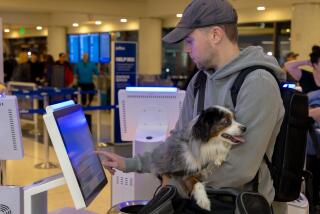Cost of air travel measured in terms of pollution, not dollars
IN the United States, air travel generates as much as 10% of transportation-based emissions of carbon dioxide, the primary greenhouse gas responsible for global warming, according to the U.S. Department of Transportation’s Center for Climate Change and Environmental Forecasting. A typical flight from Los Angeles to New York, for example, generates 1 ton of carbon dioxide per passenger.
To spread the word about travel’s contribution to global warming, online travel agencies Expedia and Travelocity this month partnered with groups dedicated to decreasing the amount of greenhouse gases released into the environment.
“There is a large contingent of consumers ... concerned with green travel,” said Expedia spokeswoman Katie Deines. “It’s important to us to offer our customers options in that vein.”
Expedia has become partners with TerraPass (www.terrapass.com), a 2-year-old company that sells customers “passes” to help offset the greenhouse-gas emissions caused by their travel.
For a round-trip flight of 6,500 miles (a bit more than a trip from Los Angeles to New York), a TerraPass costs $17; for international flights, $30.
Expedia gives all the money directly to TerraPass, which invests in projects designed to decrease carbon emissions in other industries. It funds clean energy projects throughout the U.S., including wind farms and biomass energy, and the generation of electricity from animal and plant material, such as cow manure.
Methane derived from cow manure has several advantages over fossil fuels, according to TerraPass. It’s renewable, which means no net carbon is put into the air, and the process reduces the amount of methane, a greenhouse gas 22 times more potent than carbon dioxide, entering the atmosphere.
TerraPass also purchases something called “carbon offsets” -- which are essentially licenses to pollute -- and retires them.
These carbon offsets are voluntary restrictions on carbon emissions to which businesses nationwide agree. If a business has an excess of them, they can be traded on the free market on the Chicago Climate Exchange. In theory, the fewer licenses on the market, the less pollution.
Such models of greenhouse gas reduction have been around Europe for years but are just catching on in this country.
The U.S. has been “a little bit behind the rest of the world in recognizing the concept,” Deines said.
One of the forerunners of this type of environmental approach to travel is the Britain-based firm Carbon Neutral Co. (www.carbonneutral.com). It has been around since 1997 (when it was called Future Forests) and performs much the same function as TerraPass.
Such programs may not be the approach many people think of when talking about improving the environment.
“It’s less about trees and more about investing in renewable energy and energy-efficient projects in developing countries that will save the equal amount of CO2,” said Carbon Neutral spokesman Jim Peacock.
For example, Carbon Neutral invests in a solar panel project in Sri Lanka that reduces dependence on greenhouse-gas-emitting kerosene.
The Conservation Fund, favored by Travelocity, takes a more traditional approach to the solution of global warming. Since its founding in 1985, the group has reforested with native trees and plants more than 5 million acres of public land that had been deforested through logging and farming activities. Trees act as a natural filter for carbon dioxide, turning it into oxygen.
“Our program ... is blending climate change with wildlife habitat and heritage” preservation, Conservation Fund President Larry Selzer said.
Through a Conservation Fund program called Go Zero, Travelocity customers can elect to donate $10 to $40, depending on the distance of the trip. Travelocity passes on 100% of the contribution to the nonprofit Conservation Fund.
“Climate change and global warming have emerged as the great environmental issue in the 21st century,” Selzer said.
Acknowledging that and providing a way for individuals to make a positive environmental contribution are the keys to solving the crisis, he said. Individual involvement was key to the success of recycling programs, and Selzer is convinced that once people understand their carbon impact, they will respond.
“When given the opportunity, the American people will participate” in environmental programs, he said.
Expedia and Travelocity say they are participating in the programs in response to consumer demand and awareness.
But some are a bit skeptical.
“Expedia and Travelocity are doing nothing more than cashing in on travelers’ sensitivity to global warming,” said Henry Harteveldt, principal analyst for travel research at Forrester Research. “Nothing wrong with that, and it’s fine they give travelers the option to participate. Just don’t mistake these for what they really are: revenue-generating opportunities for the agencies.”
Still, awareness that travel has an effect on the environment is a good thing, and the agencies aren’t taking a cut of the donations. Plus you don’t have to buy from one of the online agencies to participate. You can go direct to the source and contribute for air travel and any other carbon-generating activities. Selzer scoffed at the idea that just traveling less would remedy the situation.
“Get out and enjoy the great natural resources,” he said. “You’ll become better stewards of them in the future.”
*
More to Read
Sign up for The Wild
We’ll help you find the best places to hike, bike and run, as well as the perfect silent spots for meditation and yoga.
You may occasionally receive promotional content from the Los Angeles Times.





